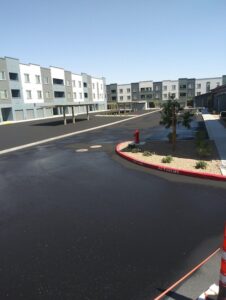
What Aspect Must Contractors Consider When Sealcoating in the Spring?
 Sealants are notoriously picky about the weather conditions that exist during and immediately after they are applied. It cannot be too cold, too humid, or too overcast if the sealant is to cure properly and quickly. If any of these factors is borderline, a fourth factor may need to be considered, which is the wind speed, and there is also a fifth factor, which is the likelihood of precipitation. Fortunately, when it comes to sealcoating in the spring, you would be hard-pressed to find better conditions than you typically find in the Las Vegas area.
Sealants are notoriously picky about the weather conditions that exist during and immediately after they are applied. It cannot be too cold, too humid, or too overcast if the sealant is to cure properly and quickly. If any of these factors is borderline, a fourth factor may need to be considered, which is the wind speed, and there is also a fifth factor, which is the likelihood of precipitation. Fortunately, when it comes to sealcoating in the spring, you would be hard-pressed to find better conditions than you typically find in the Las Vegas area.
What Is Considered Too Cold for Sealcoating?
Temperatures play an important role in the curing of sealants, but it should not be forgotten that they can also affect a contractor’s ability to perform certain types of pavement crack sealing, crack filling, or other repair procedures that need to be completed prior to sealcoating. Sealant manufacturers specify minimum temperatures in the neighborhood of 50 degrees Fahrenheit. The minimum applies to both the surface and ambient temperatures, and these can sometimes vary significantly. However, this is seldom a problem in the springtime in the Las Vegas Valley. After spring officially arrives on March 21, overnight lows seldom drop below 50 degrees, so the temperatures are typically well within acceptable ranges by the time that the sun has been up for an hour or two.
What Is Considered Too Humid to Apply Sealcoating?
Sealant manufacturers recommend humidity levels of less than 50% during the application process and for the first 24 hours thereafter. Manufacturers warn against applying their products if the humidity exceeds 90%. Unless the monsoon season arrives early, springtime humidity levels in Las Vegas will typically range between 16% and 25%, so humidity is seldom an issue for sealcoating.
How Do Overcast Skies Affect a Job?
A surface that is exposed to direct sunlight warms up faster, and it stays warmer longer. In turn, this boosts the rate of evaporation, so sealants cure faster. April, May, and June are typically the driest months in Las Vegas, and they are also among the sunniest. Although the weather patterns are subject to change, you will not see many springtime days on which the skies are overcast.
How Does Wind Speed Affect Springtime Sealcoating Jobs?
Wind speed comes into play when other conditions are marginal. Wind helps expedite evaporation, especially when temperatures are borderline, skies are somewhat overcast, or humidity levels are slightly elevated. In the Vegas area, springtime winds are usually ideal for sealcoating. There will be just enough of a breeze to stir the air over the wet sealant, but the winds will not be strong enough to interfere with the application.
Why Does the Likelihood of Precipitation Matter When Sealcoating in the Spring?
If rain falls on uncured sealcoating, the job can be ruined, so sealcoating contractors want to make sure that there is no precipitation in the forecast for at least 24 hours after the completion of a sealant application. In some parts of the country, spring is typically the wettest season, and some of these areas receive more rain in the springtime than Las Vegas receives in a year. In the Vegas area, spring is usually the driest season, which is just another benefit for an asphalt contractor who performs sealcoating in the springtime.
If You Have Questions, We Have the Answers
Affordable Striping & Sealing is a highly respected asphalt maintenance company serving the entire Las Vegas Valley. Our services include asphalt sealcoating, parking lot striping, crack filling, pavement markings, parking lot design, road markings, parking lot signage, and bumper blocks. We are known for delivering exceptional results at affordable rates. If you wish to receive a free quote, you can complete our online form, or you can give us a call at 702-222-9009.



